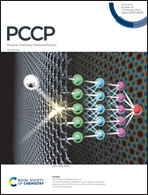Rational design of [e]-fusion induced high-performance DHP/CPD based photoswitches
Abstract
We report an effective strategy for improving the electronic transport and switching behaviors of dimethyldihydropyrene/cyclophanediene (DHP/CPD)-based molecular devices, an intriguing photoswitch that can be triggered by ultraviolet/visible (UV-vis) light irradiation. Aiming to obtain molecular devices with high on–off ratios, we assess a series of molecular designs formed by [e]-fusing different arenes on a conjugated macrocycle to modulate the photochemical and electronic properties. Here, the switching mechanism and transport properties of [e]-fused DHP/CPD-based nanojunctions are theoretically investigated by first-principles calculations. As a result, the large diversity in electrical conductance between the closed and open forms certifies the substantial switching behavior observed in these sandwich structures. The maximum on–off ratios in all designed photoswitches are greater than 102. Further analysis confirms the improvement of switching performance caused by [e]-fusion. Notably, in the benzo-fused molecular junctions, the maximum on–off ratio is up to 103, which is 55 times larger than that of the un-fused one. We also find that the position of the switch core can remarkably affect the performance of photoswichable nanodevices.
![Graphical abstract: Rational design of [e]-fusion induced high-performance DHP/CPD based photoswitches](/en/Image/Get?imageInfo.ImageType=GA&imageInfo.ImageIdentifier.ManuscriptID=D0CP03827J&imageInfo.ImageIdentifier.Year=2020)


 Please wait while we load your content...
Please wait while we load your content...